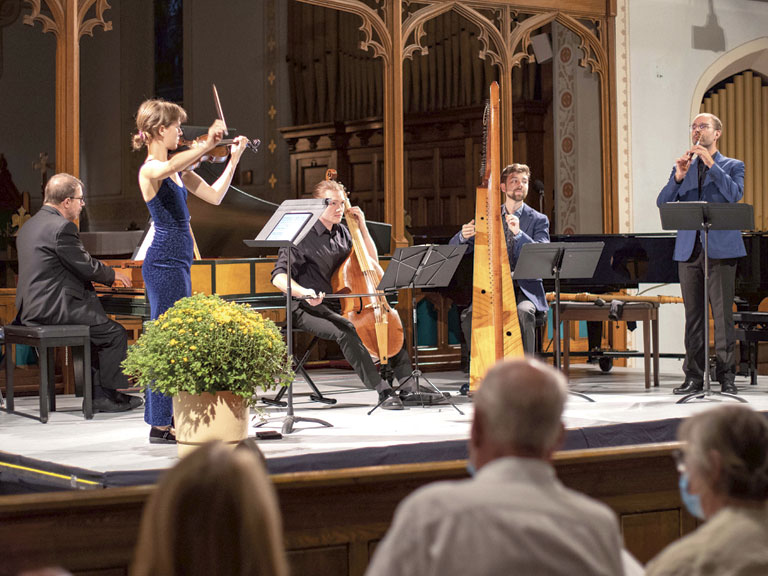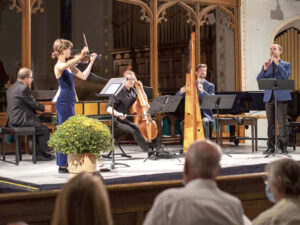County News
Basta Parlare

Chamber music played on early instruments
The sound of seventeenth-century music played on instruments appropriate to the era filled the space within St Mary Magdalene Church on Saturday night. It was the second concert in a six-part series that continues next Friday, Saturday and Sunday. The ensemble Basta Parlare plays instruments that were designed at the dawn of the Baroque period, around 1600. Four of the five players actually started on the modern instrument equivalent before being drawn to the forerunners. Hank Knox started playing the piano. “I had to play scales and arpeggios, and that was not a lot of fun, so I ended up in a rock and roll band,” he said. He discovered that the harpsichord had a similar chord structure to that used in rock and roll, and that set him on the path to playing early Baroque music on the instrument. It is very different from a modern piano, with an old style of tuning, so some of the piano chords sound incredibly dissonant when played on the harpsichord.
Marie Nadeau-Temblay started her musical journey on the normal violin, but she said that something didn’t feel quite right. While at university she heard the sound of early music and asked to join a Baroque orchestra. The old violin uses a different type of bow, and the strings are made of animal gut. “I struggled a lot at the beginning; it took me years to get used to the tuning. We don’t tune to A440; the standard is a semitone lower than that. I have perfect pitch, so it was a lot of work to adjust my hearing to the new tuning, but I persevered and here I am,” she said. The organic strings are much more sensitive to temperature and humidity, and the players have to tune frequently during the performance.
Tristan Best plays the viola da gamba, but started off as on a jazz guitar program at a university in Nova Scotia. “It wasn’t that much fun to play. Then I took an intro to music history course and I heard just a fivesecond sound of a viola da gamba, and I had to stop and listen to it again and again, and I knew from that moment it was something I had to learn about. I was really fascinated because the instrument is so similar to a guitar, so all the things I had been practicing with my left hand was really the same thing. It was a lot of fun and I really fell in love with it,” he said.

The ensemble Basta Parlare play at St. Mary Magdalene Church on Saturday night. (L-R): Hank Knox, Marie Nadeau-Tremblay, Tristan Best, Antoine Malette-Chénier and Vincent Lauzer.
Antoine Malette-Chénier played the modern harp, and he became fascinated by the creativity needed to play early music, which he likens to a language with a distinct syntax and grammar. He started to play the triple harp, an instrument designed in the 1580s in Italy. There are few surviving examples from that era, none of which are playable. Malette-Chénier’s harp is a modern construction based on a harp that was pictured in a painting from the period. The final member of the quintet, Vincent Lauzer, has always played the recorder, which has been essentially unchanged for centuries. He started playing just a little before he was five years old, and for Saturday evening’s concert he played three different types of recorders, and explained the different sounds produced by each instrument.
The ensemble played a selection of music written by composers in the early to midseventeenth century. Although harpist Malette-Chenier describes the music as being simpler than the music of the later classical period, it still requires a great deal of skill to play, in part because the composers didn’t provide a lot of information on the score. “There’s an element of freedom that is fun for the audience as well as for the performers,” he said.
The Prince Edward County Chamber Music Festival continues this Friday, Saturday and Sunday at St. Mary Magdalene Church in Picton.
For tickets or more information, please visit pecmusicfestival.com

Comments (0)